SOFIA and the Infrared Universe Gallery gallery
| Title | Image |
|---|---|
|
SOFIA Observations of Cloud Collisions
Caption
Artist's impression This image shows a star cluster forming from the collision of turbulent molecular clouds, which appear as dark shadows in front of the background galactic star field. Star clusters are conceived in the hearts of optically dark clouds where the early phases of formation have historically been hidden from view. But these cold, dusty clouds shine brightly in the infrared, so telescopes like SOFIA can begin to reveal these long-held secrets. The molecular clouds are surrounded by atomic envelopes, here illustrated in green, which have been detected via emission from ionized carbon by the GREAT instrument on board SOFIA. The spatial offset and motions of these envelopes confirm predictions of simulations of cloud collisions.
Credits
NASA/SOFIA/Lynette Cook
|
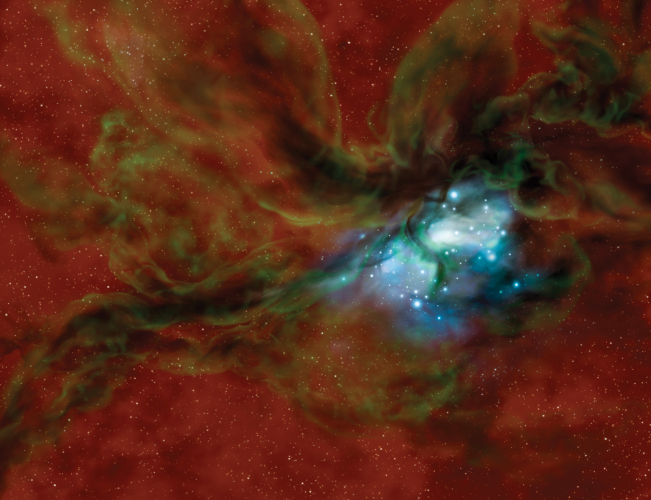
|
|
SOFIA Observations of Comet Pan-STARRS
Caption
Artist’s impression The short and long wavelength cameras on the FORCAST instrument were used to study light emitting from Comet C/2012 K1 (also called Pan-STARRS). The observations focused on the coma, the gas and dust that form around a comet’s nucleus as it is heated by the sun. The data were used to deduce the size and composition of the dust grains and to identify and categorize their thermal properties. These observations revealed weak silicate emission features from the comet, rather than the anticipated strong silicate features found in some prior Oort Cloud comet observations, including those of Comet Hale-Bopp and studies conducted with the Spitzer Space Telescope.
Credits
NASA/SOFIA/Lynette Cook
|

|
|
SOFIA Observations of Cygnus A
Caption
Artist’s impression Cygnus A, surrounded by a torus of dust and debris with jets launching from its center. Magnetic fields are illustrated as thin ribbons trapping the dust. Cygnus A is the closest and most powerful active galaxy, the perfect candidate to study the role magnetic fields play in confining the tori of the unified model, channeling material into supermassive black holes and launching jets at relativistic speeds. SOFIA observed the central 20 pc of Cygnus A with the HAWC+ instrument at 53 and 89 μm and an angular resolution of 5 and 9 arcseconds. These observations are sensitive to temperatures of 30–50 K and show highly polarized infrared emission dominated by a well-aligned dusty structure.
Credits
NASA/SOFIA/Lynette Cook
|
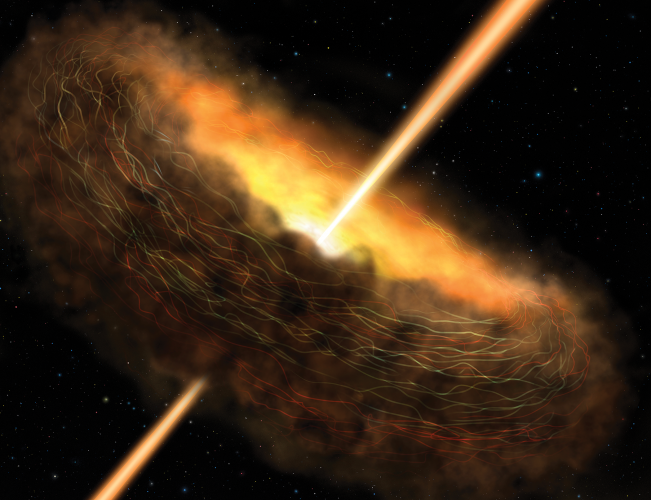
|
|
SOFIA Observations of the Epsilon Eridani System
Caption
Artist’s impression This image depicts the Epsilon Eridani system, where a Jupiter-mass planet orbits its parent star at the outside edge of an asteroid belt. Another narrow asteroid or comet belt plus the outermost belt (similar in size to our solar system’s Kuiper Belt) appear in the background. Observations from the FORCAST instrument confirmed the existence of the asteroid belt adjacent to the orbit of the Jovian planet. The strongest infrared emission from the warm material surrounding the star, at wavelengths between 25–40 μm, is undetectable by ground-based telescopes because of strong absorption by the Earth’s atmosphere. The similarity of the structure of the Epsilon Eridani system to our solar system is remarkable, even though Epsilon Eridani is much younger than our sun.
Credits
NASA/SOFIA/Lynette Cook
|
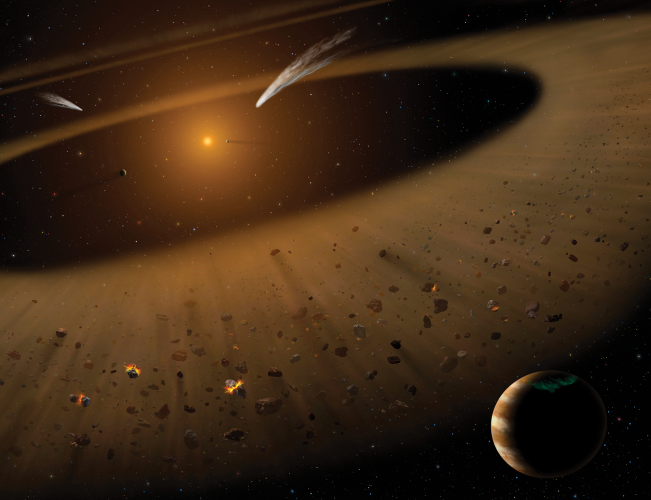
|
|
SOFIA Observations of Dusty Tori
Caption
Artist’s impression This image shows the thick ring, or torus, of dust that can obscure the energetic processes that occur near the supermassive black holes that power active galactic nuclei. The FORCAST instrument was used to observe the infrared emission around 11 supermassive black holes with active galactic nuclei located at distances of 100 million light-years and more. The resulting observations were used to determine the size, opacity, and distribution of dust in each torus. SOFIA observations suggest that the dust distribution is about 30 percent smaller than previously thought.
Credits
NASA/SOFIA/Lynette Cook
|
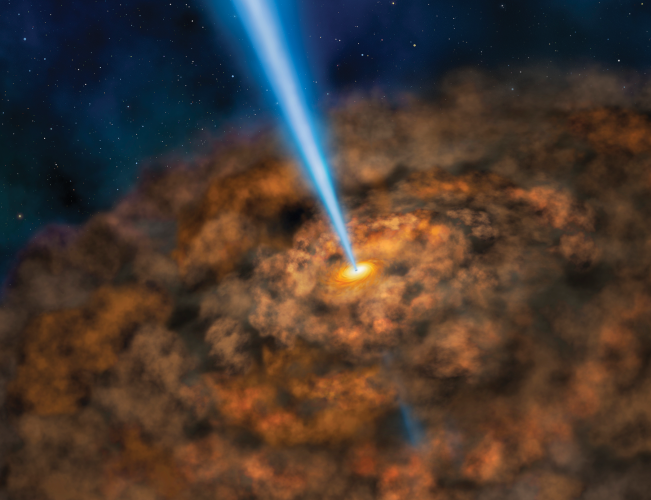
|
|
SOFIA Observations of the “New Starry Nights”
Caption
The Orion Nebula is among the best observed and most photographed objects in the night sky. It is the closest star-formation laboratory to Earth. Streamlines show the magnetic field morphology determined from 53 μm polarization maps obtained with SOFIA’s HAWC+ instrument. These are superposed on an infrared image taken by the Very Large Telescope in Chile, which shows the Trapezium stars in white and the Becklin-Neugebauer object in pink. SOFIA’s HAWC+ instrument is sensitive to the alignment of dust grains, which line up along magnetic fields, letting researchers infer the direction and strength. The polarimetry observations have produced some of the most detailed magnetic field line maps to date, with spatial scales of ~0.01 pc (53 μm band).
Credits
NASA/SOFIA/D. Chuss/ L. Proudfit
|
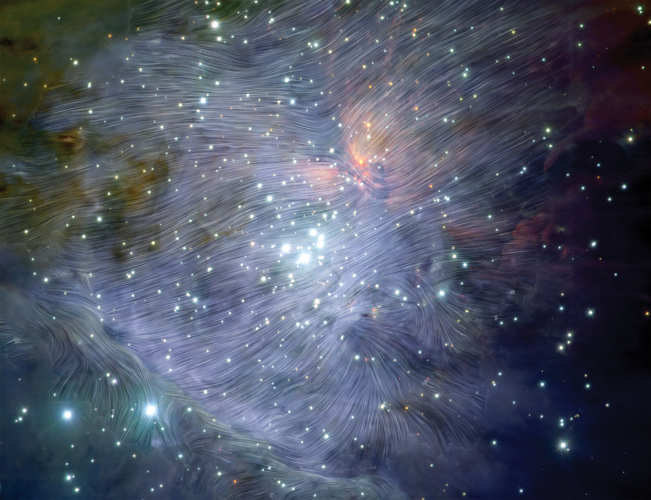
|
|
SOFIA Observations of M82
Caption
Messier 82 is a starburst galaxy about 12 million light-years away in the constellation Ursa Major. Streamlines show the magnetic field morphology determined from 53 μm polarization maps obtained with SOFIA’s HAWC+ instrument. The image combines visible starlight (gray) and H-alpha emission (red) from the Kitt Peak 2.1 m (Spitzer Infrared Nearby Galaxy Survey Legacy project), and near-infrared and mid-infrared starlight plus dust from Spitzer and SOFIA (3.6 and 53 μm; yellow). The magnetic field is clearly perpendicular to the plane of the galaxy and appears to follow the bipolar outflows generated by the intense nuclear starburst. This geometry extends over a region at least 700 parsecs (pc) along the disk and up to 200 pc above and below the plane.
Credits
NASA/SOFIA/E. Lopez-Rodriguez/W. Reach/L. Proudfit
|
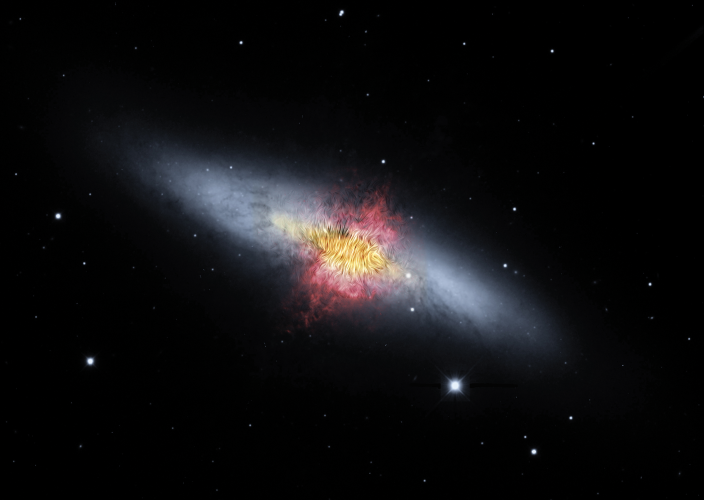
|
|
SOFIA Observations of W51A
Caption
W51A is one of the largest and brightest star-forming regions in the Milky Way. It lies 18,000 light-years away in the constellation of Aquila. This image is composed of mid-infrared data from the FORCAST instrument for the SOFIA Telescope (FORCAST; 20 μm=blue; 37 μm=green), and Herschel far-infrared data (70 μm=red). Colors trace the warm emission from dust that is being heated by the ongoing star formation activity. The star field is from Sloan (0.9 μm). These data reveal, among other things, a young stellar object of up to ~100 solar masses, a candidate for the most massive young star in the Milky Way. These results demonstrate that FORCAST is a powerful tool to trace deeply embedded massive young stellar objects.
Credits
NASA/SOFIA/J. De Buizer/W. Lim
|
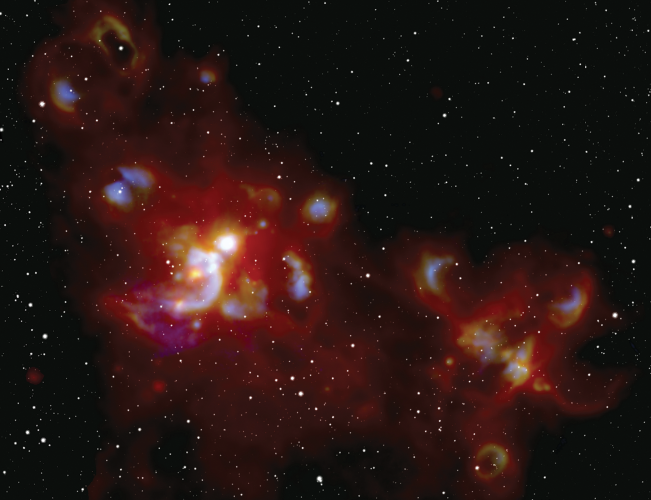
|
|
SOFIA Observations of Orion’s Dragon
Caption
Far-infrared imaging spectroscopy of the Orion nebula from SOFIA upGREAT. Over 2 million [C II] 158 microns (μm) spectra create a 3-D data cube of right ascension, declination, and line-of-sight velocity. As the cube turns around the vertical axis, the dragon figure is revealed as the rotation approaches 180 degrees. A stellar wind from the star, Theta1 Orionis C, has created a bubble by sweeping up over 2,000 solar masses.
Credits
NASA/SOFIA/A. Tielens/C. Pabst/R. Taylor
|
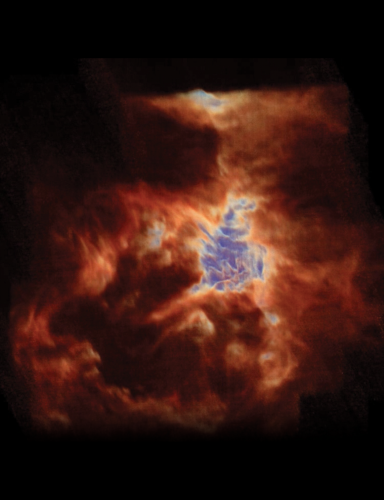
|
|
SOFIA Observations of the Galactic Center
Caption
Color shows the SOFIA FORCAST and HAWC+ image of the dusty arcs that surround and possibly feed the massive black hole at the center of our Milky Way galaxy. Streamlines show the magnetic field morphology from SOFIA HAWC+ polarization maps. This combination allows us to compare the direction of the magnetic field and the orientation of the dusty material. The star field is from Hubble Space Telescope Near Infrared Camera and Multi-Object Spectrometer.
Credits
NASA/SOFIA/D. Dowell/W. Reach/L Proudfit
|
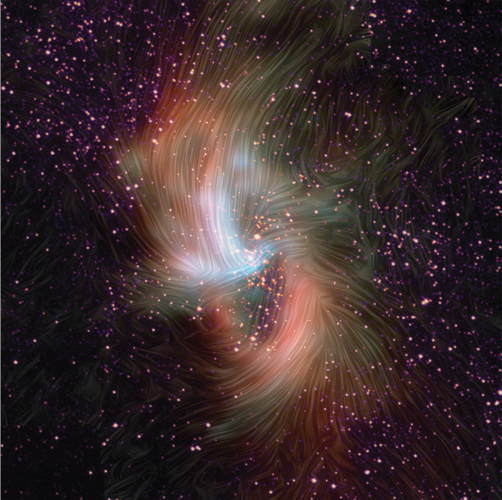
|
|
SOFIA Artist Concept
Caption
Artist’s impression California artist Lynette Cook created an impressionistic montage that includes the SOFIA aircraft set against the types of cosmic phenomena that SOFIA observes, including a star-forming region, the Orion Nebula, comets, a supernova, a variety of biogenic molecules, a protoplanetary disk, Jupiter-like extrasolar planets likely to have moons, and various galaxies, including the Milky Way. SOFIA’s instruments — cameras, spectrometers and polarimeters — operate at near-, mid- and far-infrared wavelengths, each suited to studying a particular phenomenon. Flying into the stratosphere at 38,000–45,000 feet puts SOFIA above 99 percent of Earth’s infrared-blocking atmosphere, letting astronomers study the solar system and beyond in ways that are not possible from the ground. SOFIA is an 80/20 partnership of NASA and the German Aerospace Center (DLR).
Credits
Copyright 2000 Lynette Cook. All rights reserved.
|

|